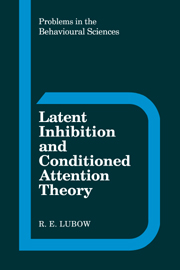Book contents
- Frontmatter
- Contents
- Preface
- 1 Introduction
- 2 Latent inhibition testing procedures
- 3 Variables affecting latent inhibition
- 4 Organismic variables affecting latent inhibition
- 5 Associative learning tests of the effects of stimulus preexposure in children and adults
- 6 Neural substrates of latent inhibition
- 7 Theories and explanations of latent inhibition in animals
- 8 Conditioned attention theory of latent inhibition
- 9 Conditioned attention theory as applied to latent inhibition in humans
- 10 Some applications of conditioned attention theory: learned helplessness and schizophrenia
- Notes
- References
- Author index
- Subject index
10 - Some applications of conditioned attention theory: learned helplessness and schizophrenia
Published online by Cambridge University Press: 13 October 2009
- Frontmatter
- Contents
- Preface
- 1 Introduction
- 2 Latent inhibition testing procedures
- 3 Variables affecting latent inhibition
- 4 Organismic variables affecting latent inhibition
- 5 Associative learning tests of the effects of stimulus preexposure in children and adults
- 6 Neural substrates of latent inhibition
- 7 Theories and explanations of latent inhibition in animals
- 8 Conditioned attention theory of latent inhibition
- 9 Conditioned attention theory as applied to latent inhibition in humans
- 10 Some applications of conditioned attention theory: learned helplessness and schizophrenia
- Notes
- References
- Author index
- Subject index
Summary
Although conditioned attention theory was developed specifically to account for latent inhibition effects, it is also relevant to other phenomena in the area of learning, particularly to those situations where the target stimulus is presented under conditions in which attention is diverted from it by competing stimuli, such as in blocking and overshadowing, or in which stimuli are presented repeatedly, as S1 in the preexposure phase of the learned helplessness paradigm, or S1–S2 in the first phase of sensory preconditioning. In regard to the first of these areas, Lubow, Weiner, and Schnur (1981) have already commented on the implications of conditioned attention theory for understanding blocking and overshadowing, as well as the feature positive effect. Similarly, in the second area, the relationships among CAT, learned helplessness, habituation, and sensory preconditioning have been explored. With the exception of learned helplessness, there is little to be added to the already published analysis, and the interested reader is referred to the original source (Lubow, Weiner, & Schnur, 1981). However, in regard to learned helplessness, new and important materials are available, enough to warrant a reconsideration of the relationship between latent inhibition and learned helplessness. In addition, a literature has recently developed on the relationship between latent inhibition, as it reflects normal attentional processes, and schizophrenia, often regarded as characterized by attentional dysfunction. These two topics, learned helplessness and schizophrenia, will be explored in the following two sections.
- Type
- Chapter
- Information
- Latent Inhibition and Conditioned Attention Theory , pp. 239 - 264Publisher: Cambridge University PressPrint publication year: 1989

